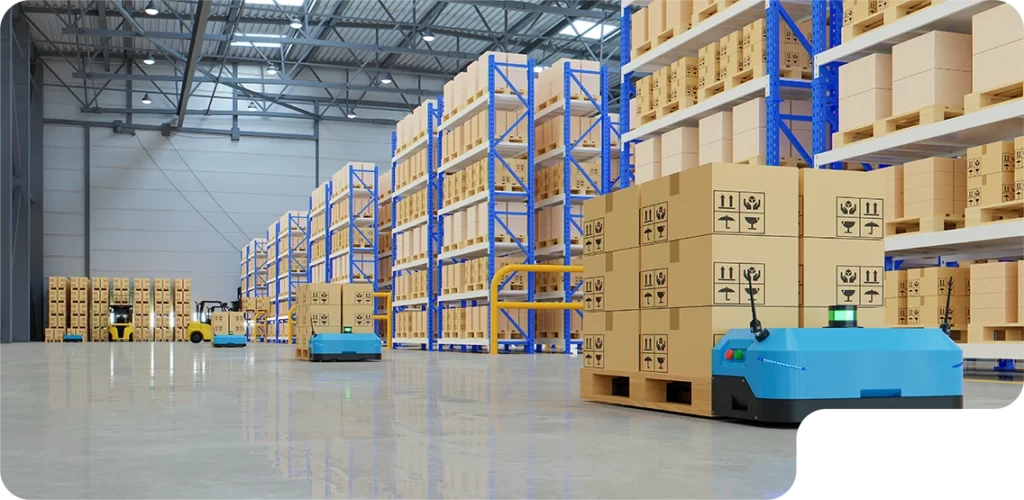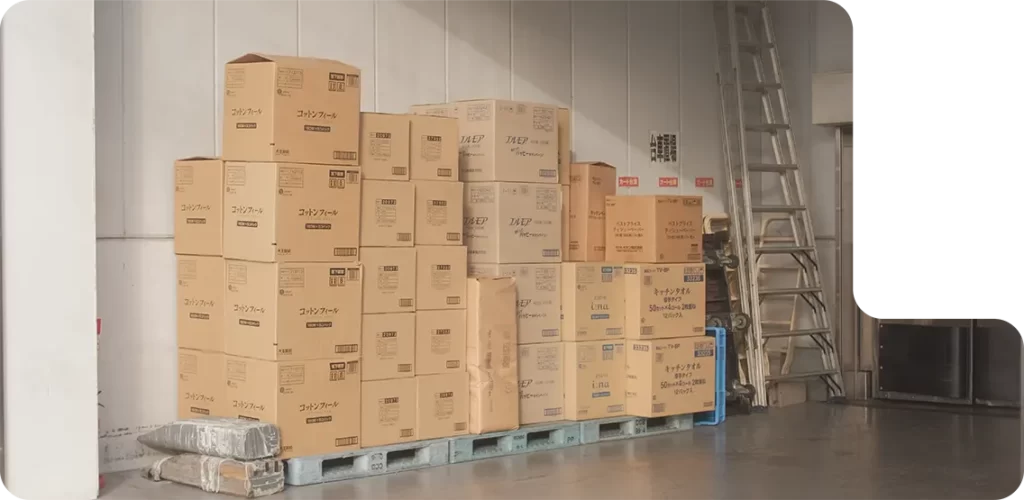Table of Contents
More Fulfillment Content
Get the PDF version via Email
Table of Contents
More Fulfillment Content
Share This
Subscribe to get the latest news!
Table of Contents
Share This
More Fulfillment Content
Get the PDF version via Email
Order fulfillment entails a series of interrelated processes, and pick and pack is one of them.
Successful order fulfillment in e-commerce goes way beyond doorstep delivery. Warehousing, inventory management, picking and packing, and returns processing are also active components in any e-commerce business. Thus, we can consider e-commerce order fulfillment a holistic process of product delivery involving all the back-end processes, from receiving an order to timely delivery to the end customer.

The pick and pack process in e-commerce logistics occurs at the warehouse and begins after an order is placed from an online store. It involves elaborate steps, and the goal of the entire process is to ensure accurate fulfillment of orders cost-effectively and in the shortest possible time.
Let’s get into more details about the pick and pack fulfillment process in e-commerce.
What is Pick and Pack Fulfillment?

In a warehouse, pick and pack is a type of order fulfillment that starts after a customer places an online order. It is most commonly used by e-commerce retailers that receive small orders and ship worldwide. Instead of assembling and shipping products in pallets and cases, the business relies on workers to pick individual items from warehouse shelves and pack them for shipment and delivery to customers.
Picking Orders
Picking begins after customers place an online order. In the picking process, the warehouse staff locates and pulls the proper quantity of products from their respective locations in the warehouse.
Packing Orders
Once the products have been picked off the warehouse shelves, the ordered items are appropriately packed with appropriate packaging material. Packing is followed by labeling the packages with shipper and customer information, bar codes, tracking numbers, etc.

Pick and Pack Strategies Explained
The pick and pack process is a lot like arranging a suitcase; you begin by selecting some clothes from your closet, followed by organizing and packing them in your suitcase. However, pick and pack fulfillment is not as simple as it sounds. In reality, a lot goes into the pick and pack fulfillment process.
Gathering items for each order and packing them into boxes is fine to begin with, but as your business scales, you need to embrace different pick and pack strategies to keep up with increasing order volumes. Your business size and the products you handle will determine the pick and pack method best for you.
Below we list some standard options a fulfillment warehouse may use for order picking and packing.
Types of Picking
Here are several basic picking methods that many warehouses rely on for fulfillment:
Piece Picking
In piece picking, the picker/employee takes the packing slip of a single order, moves around the warehouse, and picks the ordered items off shelves. Once all the order items have been gathered, the employee takes them to the packing station to be packed. Piece packing is one of the simplest pick and pack methods, ideal for small businesses.
Batch Picking
More or less similar to piece picking, batch picking is effective if a business has enough orders to group into batches. Each individual- batch of orders includes items that can be found in the same warehouse area, making it easier for pickers to find items on shelves. Rather than pick and pack each order as it comes in, batch picking is more efficient.
Zone Picking
Zone order picking works best for large fulfillment warehouses where each picker is assigned a specific area of the warehouse to pick one order at a time from that area. Once picked, the order is passed off to a picker in the next zone. After an order has moved through all the zones that contain the items on the packing slip, it is sent to the packing station.
Wave Picking
A blend of batch and zone picking, wave picking involves workers picking items within a particular zone for a batch of orders instead of a single order. Therefore, workers stay within their respective zones but pick multiple orders at a time. Then they transfer the batch to the next zone when it is ready for picking.
Cluster Picking
The cluster picking method is used to fulfill multiple orders simultaneously. Pickers travel through the warehouse, retrieving order items on multiple order/pick lists and collecting them into separate containers/bins. Cluster picking eliminates frequent trips to the picking location.
Types of Packaging
Packaging is an integral aspect of the e-commerce fulfillment process, and it’s important to distinguish between the various levels of packaging since each is suited for different types of products.
Below we give an overview of the three types of packaging that together form a typical packaging line:
Primary Packaging
Commonly referred to as a consumer unit, primary packaging is the first level of packaging that stays in direct contact with the product. The primary purpose is to preserve the product and protect it from damage and contamination. The first layer of packaging, it is mostly intended for the end consumer. The primary packaging may convey printed information to consumers, such as the cardboard box containing the cereal pouch.
Secondary Packaging
The secondary packaging is the second layer used outside the primary packaging to create a SKU (stock-keeping unit). An SKU is a group of smaller products collated to create a single package. The secondary packaging adds an additional layer of protection to preserve the integrity of the primary packaging and often serves as a container for smaller shipments. Secondary packaging materials are made up of various components such as boxes, bags, papers, separators, padding, etc.
Tertiary Packaging
Tertiary packaging is used for packing larger quantities of stock-keeping units to transport them from one location to another. Thus, tertiary packaging comes in handy when products are handled at distribution units. It protects products from damage, facilitates handling and storage, and makes it easier to transport large shipments. A stretch-wrapped pallet of cardboard boxes is an example of tertiary packaging.

Pick and Pack Warehouse Setup
A pick and pack warehouse is where products are stored for fulfillment. The pick and pack warehouse staff ensures that the ordered items are correctly picked and packaged for shipping to the customer.
Designing a warehouse is more than just putting up shelves to stack products. Before planning a pick and pack warehouse, you must understand what goes into setting up a warehouse layout, the warehouse processes to keep in mind, and layout best practices.

Setting Up and Designing a Pick and Pack Warehouse
The design of a warehouse should optimize and streamline storage and fulfillment workflows. Designing a warehouse entails:
- Finding a warehouse space that suits your business needs
- Warehouse space optimization for inventory management, cost minimization, and order fulfillment
- Purchasing equipment such as conveyors and forklifts
- Implementing technology to automate inventory fulfillment
- Staff hiring, training, and management
- Regular warehouse audits
- Obtaining proper certifications and licenses
- Regulatory compliance
Pick and Pack Warehousing Processes to Consider
Adaptability and functionality are paramount when designing the layout of a pick and pack warehouse. In addition to ensuring that you have enough space to stock your inventory, you must think of how you can enhance productivity, optimize the available space, and minimize costs.
Here are the key fulfillment processes you should consider while designing the layout of a warehouse:
Receiving and Storing Inventory
A warehouse receiving process that’s not up to the mark will result in stock control issues and increase operational costs. Thus, the warehouse staff must be quick and efficient in handling incoming inventory and verifying its quality and integrity. Depending on the type, size, and volume of products you handle, you would require storage shelves, bins, palettes, and heavy lifting equipment.
Inventory Tracking
Receiving inventory is just the first step. After that, you will need an inventory tracking system to determine what is available for sale. Although a manual approach to inventory management does the job if you’re handling small orders, it will become costly and inefficient once order volume increases. Investing in inventory management software will help you track inventory levels in real-time so that you can maintain the appropriate stock level to meet demands.
Warehouse Picking
The warehouse setup and layout should allow smooth, efficient, and accurate picking. While you figure out ways to streamline the picking workflow, consider how much your picking team has to move around to pick items, how you will issue and assign picking lists, how the picker will know where in the warehouse items are located, and the picking strategies you will apply. How you design the picking workflow will determine how quickly and accurately items are picked.
Shipping
The warehouse team is responsible for ensuring the accurate picking, packing, and shipping of products. Hence, the warehouse must have ample room to accommodate large product volumes for simultaneous loading onto trucks. Alternatively, you can partner with shipping carriers and share order tracking updates with your customers so that they’ll know when to expect delivery.

Pick and Pack Warehouse Layout Best Practices
The specifics of your warehouse design depend on your business and the nature of the products you handle.
Make a Blueprint of the Internal Warehouse Workflows and How They Connect
The warehouse plan must be based around dock doors since these are the points where carriers will pick up and drop off goods.
Adapt and Optimize Warehouse Picking Processes
It is crucial to plan out a picking workflow and continuously improve the picking and packing processes to maintain accuracy and efficiency. Using order picking software is an excellent strategy.
Choose the Right Inventory Storage System
An inventory storage system is a solution that helps a business store, manage, and track inventory. You must determine an inventory storage system to optimize carrying costs and ensure accurate and efficient picking, packing, and storage.
Factor in the Setup of Warehouse Workstations
Your warehouse layout design should provide a comfortable working space for employees and staff. A one-way workflow is the most practical and efficient way to design warehouse workstations.
Work With Your Employees
The picking team and other staff working at your warehouse best understand the warehouse layout and how it can be optimized. Speak to them and get their feedback to bring any change that makes their everyday warehouse tasks more convenient.

How does the Pick and Pack Process Work?
Whether you outsource pick and pack fulfillment or manage it in-house, the basic steps of the process remain the same.
Here’s an outline of the pick and pack process and how it works:
- The fulfillment warehouse is notified as soon as a customer places an online order.
- A packing slip detailing the shipment contents is generated for the order.
- Warehouse staff pick the items described in the packing slip. Piece picking, batch picking, zone picking, wave picking, and cluster picking are widely used picking strategies.
- Members of the picking team take the ordered items to the packing station, where they are packaged and labeled for delivery to the customer.
- The packages reach the loading station for sorting.
- Finally, shipping carriers pick up the orders for delivery to customers.
Why You Should Consider a Pick and Pack Warehouse for Your Business
Now that we have discussed the basic concept of a warehouse pick and pack system, its benefits are worth looking at. Regardless of the nature of products you handle, you should consider a pick and pack warehouse for the following reasons:
Organization
A pick and pack system keeps the warehouse organized, allowing workers to conveniently do their job without wasting valuable time.
Speed
With a pick and pack system come trained employees who know what they need to fulfill an order and where to get it, thereby speeding up the process.
Efficiency
With organization and speed comes efficiency. A pick and pack warehouse is the answer to efficient and optimized logistics, especially when you have high product volumes to ship faster.

Outsourcing Pick and Pack
As your business grows, you may reach a point when in-house fulfillment fails to keep up with order volumes and customer expectations. Hence, it becomes necessary to consider outsourcing picking, packing, and shipping services to a third-party logistics (3PL) provider.
In the simplest terms, picking, packing, and shipping involves:
- Receiving customers’ orders.
- Pulling the ordered items out of the warehouse inventory.
- Packing the orders with appropriate packaging material.
- Shipping the orders to customers.
While the pick, pack, and ship process sounds simple enough to be completed in-house, outsourcing the process to a 3PL fulfillment company can help speed up the growth of an e-commerce business. Each step of the fulfillment process entails critical considerations that require the industry expertise of a third-party fulfillment partner. The fulfillment partner can seamlessly integrate with your e-commerce order management system to offer the best services for your products, including real-time inventory management, transportation, and shipment tracking.
Why Should You Choose a 3PL Center for Pick and Pack?
Reduced Overall Costs
Outsourcing pick and pack fulfillment to a 3PL has its costs, but it does not take away the fact that in-house fulfillment is more expensive and inefficient in the long run. Since 3PLs have an extensive network, they are more likely to have valuable industry contacts and can negotiate shipping rates better, bringing down overall fulfillment costs.
Industry Expertise
Partnering with a 3PL helps e-commerce businesses leverage industry expertise that may not have been possible by managing in-house fulfillment. Since the entire focus of 3PLs is on distribution, fulfillment, shipping, and other supply chain operations, they have the necessary experience and expertise to get the job done.
Scalability
A primary reason e-commerce companies outsource pick and pack to a 3PL is because third-party fulfillment partners help in business growth. A fulfillment partner’s logistical infrastructure allows companies to scale their fulfillment and distribution operations without investing in elaborate setups and facilities.
Improved Customer Satisfaction
When all the above benefits combine, the result is an optimized, efficient, and accurate fulfillment process directly impacting customer satisfaction. With a 3PL, online sellers can rest assured that their customers will receive on-time delivery, improving customer experience and driving more sales.

Top Things to Look for in an E-Commerce Pick and Pack Fulfillment Service
Once you consider all the perks of outsourcing pick and pack fulfillment, you must choose a 3PL partner to work with.
While there is no one-size-fits-all approach, here are some features you can look for while considering a potential e-commerce pick and pack fulfillment service:
Location
Consider if the location of the fulfillment company aligns with where most of your customer base is to prevent shipping delays.
Pricing
Pricing models vary across fulfillment services, and you must consider the various costs associated with processing and fulfilling orders.
Services Provided
Ensure that you choose a fulfillment provider that provides services to meet your business needs.
Support
Ensure that you can quickly contact your fulfillment service provider with any issues or questions.
Shipping Policies
Since shipping is a crucial component of fulfillment with a significant impact on customer satisfaction, ensure that your fulfillment provider offers features like 2-day shipping, shipment tracking, etc.
Reputation
Before choosing a fulfillment company, verify its reputation by checking customer reviews and testimonials.
Conclusion
Pick and pack fulfillment is an integral part of e-commerce orders which is why it’s important for entrepreneurs to understand it fully. If you are looking for a pick and pack fulfillment partner, you must also understand what are the things to look out for.
Sign up today and leave the logistics to us
Sign up and we will get back to you within 24 hours to discuss what services would be best for your business needs. Or speak with us now and tell us what you need.
FAQs
Pick and pack fulfillment refers to the process of receiving online orders, picking the ordered items off warehouse shelves, packing the items, and shipping them to the customer.
A pick list is a document assigned to a warehouse picker describing the list of items to pick from a warehouse for order fulfillment.
Shipping is one of the crucial steps of a fulfillment process and takes place after picking and packing ordered items.
A pick and pack service typically refers to a third-party fulfillment company that carries out outsourced warehousing, picking, packing, shipping, and other fulfillment activities.
Here are a few tips to improve warehouse picking and packing:
- Consider different pick and pack strategies
- Choose the right inventory storage system
- Optimize storage space
- Implement automation technology